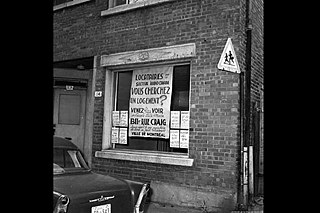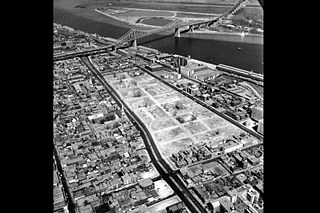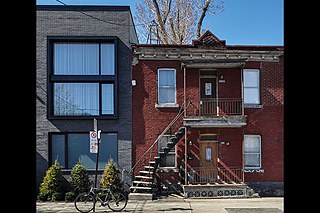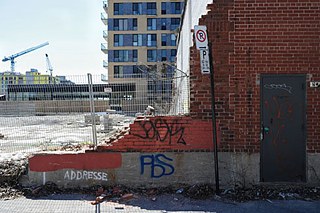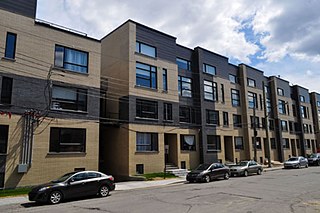Ballad
A Suburb Named Montréal
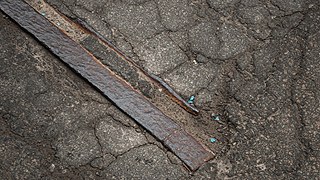
Haunted by the ghosts of the past and mistreated by the ideology of progress, which is confirmed by the suburbanization of neighbourhoods, Montreal is starting to forget itself and is slowly fading away. A historical and critical walk with strolling journalist and historian Jean-François Nadeau.
Built on an island Montreal turns its back, however, on the water, turned in on itself. To approach it you have to unravel the threads of the highway architecture of the 1950s. On these expressways perched on concrete structures you can picture the automobile of the time as an eagle descending from the sky onto the haunts of the worker ants. Montreal had had its tram tracks covered over but nevertheless they come back to haunt it each springtime after the winter freeze when the old metal resurfaces through the asphalt on the main thoroughfares.
Montreal is cut from a different cloth from that of Quebec City. It doesn’t possess the smooth charm and plastic beauty that constitute the pride of those cities with so-called world heritage status. Houses in elegant rows, streets delicately designed, wrought iron grating, that’s not Montreal, except for a tiny part of the old town, formerly protected from the Indian attacks by a wooden stockade.
Old things, old people: for a long time Quebec has wanted to present itself this way to the North American visitor. By habit the St Laurence valley has continued to see itself this way, to admire itself through a tradition morbidly absorbed with the times gone by, in which the past is seen as an act of embalming needed to preserve the idea of a country meant to please others, a country that only becomes ours with this end in view. On the banks of the great river “nothing must die, nothing must change”, Louis Émond observed in his novel Maria Chapdelaine. ”Our master, the past” the cassocked minds would repeat thereafter.
However, all this past has long since disintegrated in the shadow of the skyscrapers erected on the spot where the Iroquois tribes used to gather at the foot of the Mount Royal. And it continues today when we gabble on about our awareness of our heritage, a convenient idea readily indulged in by us humans, happy not to have to think ahead when history and collective life are at stake.
In Montreal the facades of the old houses bordering the commercial thoroughfares have been shattered. You see this when on a stroll your eyes take in the other side of the street: the surge of small and large businesses has grafted new additions onto the old already existent structures. This results in facades of very different sizes advancing and retreating from the street and making for constantly uncertain perspectives.
In Montreal tens of thousands of people were similarly displaced and then forgotten about.
And they have gone on demolishing since. St. Lawrence Boulevard, former Mecca for burlesque theatre in North America, now only offers to the eye an unflattering string of empty lots and abandoned buildings, interrupted, it is true, by brand new buildings with the cold look of what some call “international architecture” preferred by money in all the countries of the world.
The same for Sainte-Catherine Street where, along with a group of other buildings, the Spectrum, that mythical music venue, was demolished before firm assurances were given that something else would be built there before long. Also disappeared in the same row of houses, the Anatolia restaurant whose sweet cakes, simply served, I loved.
In the Griffintown neighbourhood the ancient factories and old houses are falling one after the other. Not so long ago I went there to see “La femme image”, a surrealist film by my friend the photographer Guy Borremans. When I now walk around the area, I’m not even capable of working out where the film might have been shown. Little by little I am losing Montreal while projects like the one in Griffintown multiply with no over-all vision.
Life in Montreal has migrated to the fringes without recognizing them as fully-fledged partners. The haughty and aloof references that are continually made about Longueuil, Laval, Brossard, Repentigny and other suburbs, united by the 450 telephone regional code, stand in the way of imagining what lies in store for Montreal.
Montreal is also going the same way. But as in all large cities we continue to believe that this suburb contains nothing more than its own bombast, that it isn’t an integral part of the city’s skeleton.
Suburbia, however, seems today to be the supreme example of a voluntary amnesia that has allowed Disneyland to take root throughout the city. In Montreal as elsewhere the culture of distraction has triumphed, as Walter Benjamin said.


